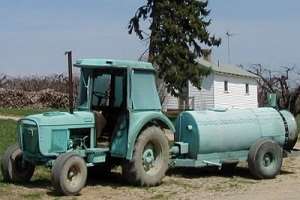By Mark Longstroth
Weather
The winter of 2016-17 was relatively warm with little snow. The coldest temperatures were in mid-December with lows just below zero. That was not cold enough to damage our Michigan fruit crops and we do not expect any winter injury. A long period of cold and snowy weather ended in late December. There was a wide spread thaw from Christmas to just after New Year’s. Most of the snow in southwest Michigan since in January and February melted soon after it fell. Relatively warm episodes have been common in February and always lead to concerns about early growth and possible crop loss. Many fruit trees have completed their chilling requirements and have broken dormancy. Maple sap flow has been underway for the past two weeks.

Relative warm temperatures have led to concerns about early growth and possible crop loss. As is typical of early spring in Southwest Michigan, the state’s extreme southern portions are more advanced than other areas to the north. Growers in the southern tiers of counties should be focusing on getting dormant sprays on now before bud break. Dormant sprays of oil, copper or lime sulfur are often used.
Tree fruit growth is just beginning. At this time, there is no immediate concern about the early growth and cold damage. It would require cold temperatures down to 10 to 15 degrees Fahrenheit or below to cause significant damage to fruit buds. Such cold temperatures seem unlikely. At this time, the main concern is for stone fruit. Many growers routinely apply copper in the dormant season to reduce diseases later in the year.
Peach leaf curl sprays should be applied to prevent infections of the swelling buds. Michigan State University Extension’s Bill Shane recommends applying control before 100 GDD base 42 to control this disease See: Treat peach leaf curl now.
Many growers also treat sweet cherries with copper during bud swell to reduce bacterial canker. Sweet cherries are sensitive to copper so this treatment should not be applied after bud break. Other stone fruit such as apricots, tart cherries and plums also benefit from early copper sprays to suppress bacterial diseases. If you use oil sprays on stone fruit to reduce San Jose scale, reduced rates and early applications are recommended.
Apples show little bud movement, although some trunk oozing has been seen. Most growers wait until green tip to apply copper as their first scab spray. Early copper applications may help also reduce fire blight. Delayed dormant sprays of oil to control mites and aphids are preferred to true dormant sprays before bud break. Pruning is underway. Fruit bud counts are relatively high. Precision pruning to reduce fruit bud numbers helps improve fruit size and encourage regular annual bearing.
Pears show little movement. Early copper sprays are used in pears to reduce fire blight.
Dormant sprays of lime sulfur (Sulforix) are often used on small fruit. Grapes show no movement and will need warmer temperatures before growth begins. Pruning wounds are not bleeding, which means the sap is not up and growth has not started.
Blueberries are showing some movement away from Lake Michigan. Many growers apply Sulforix as a general cleanup fungicide in the spring. This early season spray is focused on reducing mummy berry and phomopsis. The soil active herbicide Velpar needs to be applied before bud break so the time for application in short.
Brambles show no movement but lime sulfur or Sulforix will reduce anthracnose on the floricanes of summer-bearing raspberries and black berries. Dormant pruning cutting back last year’s primocanes should be completed soon. Fall-bearing raspberries should be cut or mowed to the ground. Lime sulfur treatments for anthracnose can be applied.
Source: msu.edu